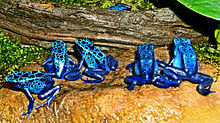- Dendrobates azureus
-
"Okopipi" redirects here. For the anti-spam software tool, see Okopipi (software tool).
Blue Poison Arrow Frog 
Conservation status Scientific classification Kingdom: Animalia Phylum: Chordata Class: Amphibia Order: Anura Suborder: Neobatrachia Family: Dendrobatidae Genus: Dendrobates Species: D. azureus Binomial name Dendrobates azureus
Hoogmoed, 1969Dendrobates azureus is a type of poison dart frog found in the forests surrounded by the Sipaliwini savannah, which is located in southern Suriname and northern to central Brazil. Dendrobates azureus is widely known as the Blue Poison Dart Frog or by its Tirio Indian name, Okopipi. It takes its species name from the fact that it is colored azure.
Contents
Physical description
D. azureus is a medium-sized frog that weighs approximately 8 grams. It grows between 3 and 4.5 cm in length and has a typical lifespan of 4–6 years in the wild. Its bright blue skin serves as a warning to predators. Its colour is also usually darker around its limbs and stomach. The glands of poisonous alkaloids located in the skin serve as a defense mechanism to potential predators. These poisons paralyze and sometimes kill the predator. The black spots are unique to each frog, serving as an identification tool. Each foot contains four toes which each have a flattened tip with a suction cup pad which is used for gripping. This species of frog is also identifiable by a hunch-backed posture.
Physical appearance also differs with the sex of the animal. Females are larger and about half a centimeter longer than males, but males have larger toes. The tips of the toes in females are round while males have heart-shaped tips.
Tadpoles vary greatly in appearance from adults. The larvae have a long tail, about six millimeters, with a total length of about ten millimeters. They lack legs and have gills instead of lungs.
Behavior
(video) A Blue Poison Dart Frog suddenly snacks on something.
Dendrobates azureus is a mainland animal, but stays close to water sources. These frogs spend most of their awake time during the day, hopping around in short leaps. They are very territorial and aggressive both towards their own species and others. In order to ward off intruders, they use a series of calls, chases, and wrestling, which usually occurs within the same sex.
Although poison dart frogs are known for their skin toxin, used on the tips of arrows or darts of natives, in reality only the species of the Phyllobates genus are used in this manner, although all poison dart frogs have some level of toxicity. In captivity, the frog loses its toxicity as a result of an altered diet.
Reproduction
The Blue Poison Dart Frog breeds seasonally, usually during the months of February or March when it is rainy. In order to find a mate, the males sit on a rock and produce quiet calls, which the female follows and tracks down the male. The females then physically fight over the male. The male takes the female to a quiet place by water to mate, which becomes the site of the egg-laying.
Between five to ten offspring are produced, and eggs are laid in the male’s territory, which he defends. The male takes care of the eggs most of the time, but sometimes the female does as well. The eggs hatch between fourteen and eighteen days, and after anywhere from ten to twelve weeks, the tadpoles are fully mature. Both sexes reach sexual maturity at two years of age. The expected lifespan of an average D. azureus is between four and six years in the wild, and about ten years in captivity.
Eating habits
Feeding on primarily insects such and other arthropods as ants, flies, spiders, and caterpillars, the Dendrobates azureus is primarily an insectivore, but occasionally feeds on non-insect arthropods. The mother provides unfertilized eggs for the tadpoles’ nutrition.
Captive care
See also: History of dendrobatid frogkeepingThe blue dart frog is very popular in captivity.[citation needed] Besides being visually appealing, D. azureus is both a hardy frog and easy to breed.[citation needed] They are highly recommended for beginner hobbyists. However, they are somewhat aggressive frogs, and are best kept in pairs.
Like most captive dart frogs, they eat a staple diet of fruit flies, pinhead crickets, rice flour beetle larvae, and springtails.
References
- Reynolds et al. (2004). Dendrobates azureus. 2006. IUCN Red List of Threatened Species. IUCN 2006. www.iucnredlist.org. Retrieved on 11 May 2006. Database entry includes a range map and justification for why this species is vulnerable
External links
 Media related to Dendrobates azureus at Wikimedia CommonsCategories:
Media related to Dendrobates azureus at Wikimedia CommonsCategories:- IUCN Red List vulnerable species
- Poison dart frogs
- Pet amphibians
- Animals described in 1855
Wikimedia Foundation. 2010.



